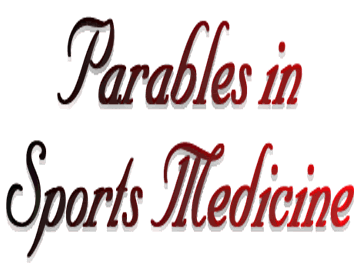

When Marilyn while playing tennis turns her ankle and falls to the ground, she is surrounded by people who wonder what happened. However none of these people know what to do about it. They help Marilyn up and over to a chair by the side of the court, as her ankle begins to throb like crazy. As she sits there with the foot resting on the ground waiting for her ride to arrive Marilyn decides to pull off her tennis shoe. That provides some relief but by the time her ride arrives the ankle deprived of the modest compression the shoe was providing has ballooned to softball proportions.
Once at home she finds the ankle hurts too much to do anything, then she remembers that for a swollen ankle you should put ice on it, or was that heat? Hobbling to the refrigerator she takes out some ice cubes and applies them, Ouch! It couldn't be ice -- that hurts too much. Perhaps a hot bath would feel much better, and so it does, but by the time her husband and children arrive home the ankle is beginning to resemble a purple cantaloupe. Marilyn then decides perhaps she should visit the emergency department and after an examination and X-Ray it is determined the ankle is sprained, the problem is that more than nine hours have passed since the injury has occurred and treatment is only just beginning.
Richard a wide receiver for his university football team is about to run a crossing pattern, one that will require him to speed down field as though going for a long bomb, then cut sharply to the inside to catch the ball. It is not to be. At the same instant, the ball and Richard, a good five yards away, thud to the ground. When he planted his foot to cut, his cleats caught in a seam in the artificial turf, turning his ankle at a right angle beneath him.
Within seconds he is no longer clutching his ankle, someone else has a hold of it. The individual examining Richard is 90% sure of what happened. He has cut of Richard's shoe and sock, and as there is no swelling yet because the injury has been attended to so promptly, he is able to examine the ankle almost as readily as though it was not injured at all. After determining the injury is a sprain, Richard is pulled to his feet, and the fact that he is willing to put weight on the ankle reinforces the diagnosis; if Richard had refused to walk on it the likelihood would increase that it may be fractured. The ankle is immediately put in a compression binding consisting of crushed ice with a firm wrap around the outside. Now he rests comfortably, with his leg elevated.
Richard starts the game two weeks later, and although he plays somewhat sparingly in his first game back he does catch a touchdown pass. Marilyn however still complains of a weak ankle three months after the injury, and needless to say has not stepped on a tennis court since.
Two people, identical injuries. With quick response, diagnosis and treatment however we end up with two very different results. The timeswing between incident and action is crucial for a speedy complete recovery, as continuing developments in sports medicine are proving.
James G. Garrick, M.D. Specializes in Sports Medicine